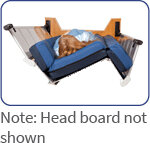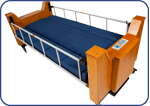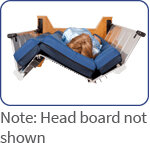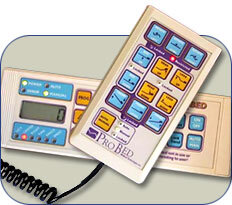the Freedom Bed™
The Freedom Bed™ is one of the most advanced lateral rotation turning beds available worldwide on the market today! DRP International is the first International Distributor of the Freedom Bed™ and has exclusivity for Australia and New Zealand
The Freedom Bed™ is a unique lateral rotation turning bed that is automated, programmable and has a voice controllable option available. Manufactured in Canada by ProBed, it is designed to meet the needs of the catastrophically injured or otherwise immobilised person with, or at risk of developing pressure injuries and other complications of immobility.
The Freedom Bed™ is engineered to provide a full range of motion to meet the unique positioning requirements of the client.
The Freedom Bed™ restores independence to users and their families, allowing them all to benefit from a good nights sleep, better health and improved quality of life.
Occupational Therapist Testimonial:
The Freedom Bed has been a contributing factor to enabling my client to move out of an aged care facility and into his own unit. He no longer requires overnight care for repositioning during the night - the Freedom Bed does this automatically for him.
We have been really pleased that the turning program can be tailored to suit his comfort and clinical requirements!
The Freedom bed has been in place for over 9 months and no issues at all. The prompt and responsive service and follow up support provided by DRP International has been fantastic. The team helped install and program the bed, then continued to check in with me to ensure it was all working well. Thank you!
Melissa (Occupational Therapist, Victoria - Australia)
The Freedom Bed is available in 3 different sizes:
Standard 1980mm length | 900mm width | 159kg patient capacity
Extended 2185mm length | 900mm width | 159kg patient capacity
Bariatric 2185mm length | 1370mm width | 272kg patient capacity
+ Applicable Medical Conditions
The clinically proven the Freedom Bed™ is recommended for persons suffering from temporary or permanent immobility which may include:
- Spinal Cord Injuries causing paraplegia and quadriplegia (with or without ventilator)
- Muscular Dystrophy and Multiple Sclerosis
- Motor Neurone disease
- Cerebral Palsy
- Severe head injuries and stroke
- Severe respiratory ailments such as chronic obstructive pulmonary disease
- Immobility due to aging
- Cancer
- Guillain Barre Syndrome
- AIDS
- Coma
- Amputations
- Osteomyelitis
- Degenerative disk disease, post-spinal fusion and laminectomy
- Rheumatoid Arthritis
- Amyotrophic lateral sclerosis (ALS)
- Any other condition where consistant turning assistance is required
Tube Fed Patients
The torso raising position is also beneficial for tube fed bed users since the bed user can still be rotated with the torso raised up to 30°.
A higher elevation angle can be achieved by combining head elevation with Reverse Trendelenburg.
Complications of Immobility, Bed Turning, Pressure / Decubitus Ulcers and More.
A mobile person generally turns approximately once every 10-12 minutes while sleeping. This action provides for healthy blood circulation, stimulation of body organs and movement of body fluids. When a person becomes temporarily or permanently immobilized however, the blood supply to that part of the body that is under pressure is restricted. If that pressure is not regularly relieved, and the blood supply restored, the affected tissue dies and sloughs off resulting in the formation of pressure wounds, bed sores or decubitus ulcer. These occur most commonly on the buttocks, sacrum, hips and heels and can be life-threatening if they become infected. This is commonly referred to as a Pressure Injury.
There are many other medical complications associated with immobility. These include (but are not limited to):
- Pneumonia
- Venous stasis
- Thrombosis
- Embolism
- Stone formation
- Urinary tract infection (kidney and bladder)
- Muscle wasting
- Bone demineralization
- Atelectasis
Decubitus Ulcers (or Bedsores)
Decubitus ulcers are of major concern to the sufferers, their caregivers, and the medical community. The scale of the problem is immense. It is estimated that approximately 400,000 people are suffering from bedsores at any one time in Australia alone and almost 70% of sufferers are over 65. It is reported that there are thousands of deaths annually from complications arising from bedsores and the current cost to the Australian Health System to treat these and other associated conditions is estimated in the tens of millions of dollars annually.
Traditional Methods of Prevention
The traditional way to avoid the formation of bedsores is for a family member, caregiver or institutional employee to regularly turn (reposition) and stabilize the patient in a new position to relieve tissue compression and re-establish blood flow. (It is recommended that this be done at a minimum of every two hours). This has to be done around the clock and unfortunately this manual process has a considerable number of drawbacks that include:
The immobilized patient is woken up during the night by the turning process Caregivers, family members or institutional staff can suffer severe back damage from the effort of lifting Family members need to be in attendance 24 hours per day and this can lead to severe sleep deprivation and severe emotional stress In institutional settings the need to frequently turn immobilized patients is costly both financially and in terms of employee time The patient may be in a home environment where the family members are unable to physically provide the necessary regular turning If support is not available at home then patients may have to be relocated to a facility leading to a loss of privacy, dignity and the inability to create a life apart from institutional living.
+ Freedom Bed™ - Benefits
The many features of The Freedom Bed provide a number of key benefits to immobilized bed-users such as:
- The automated turning process allows for more frequent turning to address the multi-system pathophysiological events associated with immobility. Also referred to as kinetic therapy, this turning not only provides pressure relief to prevent or treat bedsores but it can also produce, for example, a dramatic reduction in the incidence of respiratory problems and urinary tract and bladder infections
- Significantly better quality of sleep since the bed-user does not have to be manually turned during the night and is not woken up by the bed turning. This creates better mental clarity, better health and an improved lifestyle, free from dependence on caregivers during the night
- The opportunity to live in a home setting instead of an facility
- Pain reduction
- The bed can still rotate when the torso is in a raised position up to 30°. This can be added to the Reverse Trendelenburg position, if suitable, for a maximum included angle of approximately 42°. A pillow adds more elevation again. Torso elevation is of significant benefit to people who are tube fed and/or respirator dependent.
- Prevention or reduction of gastro-esophageal reflux
- Better respiratory health and clearance of upper respiratory and oral secretions
- Reduction in spasticity and abnormal tone.
- Discomfort
- Improved bowel regularity
- No dehydration and subsequent electrolyte imbalance since the bed creates no heat
Benefits for Home-Based Caregivers
The physical and mental tasks associated with caring for immobilized persons can place a considerable burden on spouses, parents, etc. The physical requirements of manually turning an immobile person frequently mean that family members become unable, through age and/or infirmity, to provide the required assistance. This results in institutionalization of the family member.
The Freedom BedTM has been designed with the caregiver very much in mind and provides considerable benefits along with the ability to provide a significantly better quality of home-based care.
The Freedom BedTM automatically turns the bed user during the night thus eliminating the need for the caregiver to get up every two hours. Sleep deprivation is considerably reduced and thus caregiver physical and mental fatigue are decreased.
There is a reduced need to manually turn or re-position the user and thus a decreased chance of the caregiver developing neck, shoulder or back injuries The head-raising and leg-raising system and bed height adjustment assists in positioning the user for personal care and for transfer to and from a wheelchair.
Benefits for Institutions Providing Care to Immobilized Patients
There are many significant benefits that accrue to institutions as a result of investing in the Freedom BedTM. These include:
- Increased productivity of nurses and facility support staff by reducing the amount of manual patient turning that is required. This allows staff members to use their time more effectively and productively in the care of their patients
- An effective way to treat and/or avoid pressure ulcers and other complications of immobility
- A method to protect healthcare personnel from debilitating back, neck and shoulder injuries (caused by moving and/or turning patients) that lead to considerable time off work and the associated costs of sick days, worker's compensation claims, and hiring of replacement staff.
- Reduced Staff Turnover, reduces costs of recruiting, hiring and training, and of using more expensive staff when CNA’s not available
- Reduction in legal claims against healthcare facilities for bedsore development.
Cost Benefits to the Health Care Industry
For an industry struggling to get its costs under control the Freedom BedTM offers significant savings by focusing on a strategy of prevention of the problems before they occur. It offers:
- Substantially reduced direct medical expenditures associated with repeat hospital admissions to treat pressure ulcers and other complications of immobility such as bladder and respiratory infections. It has been found that prevention of bedsores is 2.5 times less expensive than treatment.
- Support for a de-institutionalizing strategy that allows chronically immobilized patients to be moved from hospitals back to their homes (or to assisted living environments)
- Avoidance of costly readmissions from bedsores or other systemic complications
- A method to reduce the length of hospital stay for specific groups of patients. Treating critically ill patients with kinetic therapy has been shown to reduce intensive care stays by up to 24 percent. Increased movement helps reduce risk of infection and complications from pneumonia and other respiratory problems that affect about 20 percent of intensive care patients.
- Significantly reduced costs of compensation claims for nursing and support staff injured during repositioning or transferring of immobilized patients. In a study conducted for the Workers Compensation Board it was found that manual lifting, transfer or repositioning of residents (without assistance from mechanical aides) was responsible for 63% of all back, neck and shoulder injuries.
- Substantially reduced time lost by nursing and support staff from neck, back and shoulder injuries. Reduces the problems of finding replacement staff.
- Significantly reduced number of staff involved in turning patients (particularly during the night). This will reduce costs and allow staff to focus on providing a significantly higher quality of care.
+ How does The Freedom Bed™ work?
The horizontal surface of the bed that supports the mattress is hinged into three longitudinal sections. The user of the bed is positioned on his/her back in the centre of the three-part platform (the sleeping platform).

As the bed smoothly and quietly rotates to one side the outer section of the three-part platform on the lower side turns up to form a “wing” which supports the body along its entire length from the ankle to the shoulder. Thus the bed-user is carefully cradled by the bed’s structure to prevent sliding and shear forces that can increase the potential of developing bedsores. Any pressure transferred to this side of the user is thus dispersed along the entire frame of the body. The wing on the upper side of the platform lowers during this process to properly balance the entire platform and provide integral strength throughout the structure. As the bed reverses the rotation the lower wing rises as the higher wing lowers so that, at the horizontal position, all three sections of the platform are horizontal. The bed then automatically rotates to the other side to complete the cycle.

The design of the bed allows for the turning of the user along the spinal axis that creates a minimal feeling of rotation (turning). The slow rate of rotation, combined with the smoothness and quietness of operation, allows the user to enjoy uninterrupted sleep throughout the night.
Another feature unique to The Freedom BedTM is the air-powered head and leg raising system that allows the user to be raised into the sitting position. The system is unique in that it can be adjusted to meet the requirements of each individual user of the bed rather than being built to accommodate the “average” person. The key benefit of the design is the low-pressure air cushions under the mattress that raise the user. These cushions of air conform to the user's body shape, and provide a complete range of ergonomic positions. This also minimizes pressure under the sacrum thus reducing the risk of pressure sores developing while elevated.

Automatic Operation
A key feature of the Freedom BedTM is its ease of operation. User-friendly control panels allow caregivers to easily program the bed for automatic use or to adjust any of the bed’s operations manually. Changing the operation of the bed from automatic to manual or from manual to automatic is a one-step procedure. Additionally, different styles of override buttons are available to accommodate the needs of users wanting to change the programming of the bed and to move from automatic to manual and vice versa. With the high number of features and functions available, there is also a system of safety “lock-outs” permitting the caregiver to determine the choice and number of functions that bed users may access from their control panel.
The functioning of the bed allows the user to be smoothly and quietly turned through a 60° range of rotation along the spinal axis- from the horizontal position to up to 30° left and 30° right. Rotation can be programmed to stop at any position to meet the specific comfort and positioning requirements of the user. Additionally it allows the bed to “dwell” at the programmed position (left, centre or right) for any period of time between one minute and a maximum of four hours. A typical turning schedule might be as follows:
- Horizontal for 30 minutes, then
- 23° right for 1 hour, then
- Horizontal for 30 minutes, then
- 27° left for 45 minutes
The program will automatically repeat with the next move being back to horizontal.


